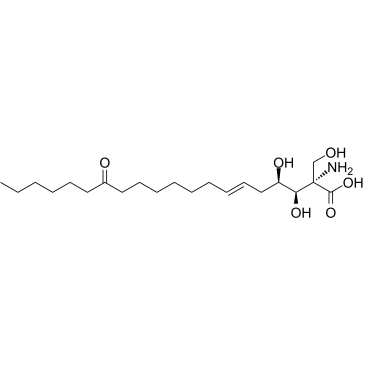Myriocin

Myriocin structure
|
Common Name | Myriocin | ||
|---|---|---|---|---|
| CAS Number | 35891-70-4 | Molecular Weight | 401.538 | |
| Density | 1.1±0.1 g/cm3 | Boiling Point | 636.7±55.0 °C at 760 mmHg | |
| Molecular Formula | C21H39NO6 | Melting Point | N/A | |
| MSDS | Chinese USA | Flash Point | 338.8±31.5 °C | |
| Symbol |

GHS06 |
Signal Word | Danger | |
|
Fungal metabolite myriocin promotes human herpes simplex virus-2 infection.
Life Sci. 120 , 31-8, (2015) Myriocin is a fungal metabolite with antiviral activity, including influenza, hepatitis B, and hepatitis C viruses. We investigated whether myriocin has activity against human HSV-2, one of the most prevalent pathogens of sexually transmitted disease.Cell cul... |
|
|
Phosphorylation of caveolin-1 on tyrosine-14 induced by ROS enhances palmitate-induced death of beta-pancreatic cells.
Biochim. Biophys. Acta 1852(5) , 693-708, (2015) A considerable body of evidence exists implicating high levels of free saturated fatty acids in beta pancreatic cell death, although the molecular mechanisms and the signaling pathways involved have not been clearly defined. The membrane protein caveolin-1 ha... |
|
|
Ceramide metabolism regulates autophagy and apoptotic cell death induced by melatonin in liver cancer cells.
J. Pineal Res. 59 , 178-89, (2015) Autophagy is a process that maintains homeostasis during stress, although it also contributes to cell death under specific contexts. Ceramides have emerged as important effectors in the regulation of autophagy, mediating the crosstalk with apoptosis. Melatoni... |
|
|
Disruption of sphingolipid metabolism augments ceramide-induced autophagy in preeclampsia.
Autophagy 11 , 653-69, (2015) Bioactive sphingolipids including ceramides are involved in a variety of pathophysiological processes by regulating cell death and survival. The objective of the current study was to examine ceramide metabolism in preeclampsia, a serious disorder of pregnancy... |
|
|
An endocytosis pathway initiated through neuropilin-1 and regulated by nutrient availability.
Nat. Commun. 5 , 4904, (2014) Neuropilins (NRPs) are trans-membrane receptors involved in axon guidance and vascular development. Many growth factors and other signalling molecules bind to NRPs through a carboxy (C)-terminal, basic sequence motif (C-end Rule or CendR motif). Peptides with... |
|
|
Interference with distinct steps of sphingolipid synthesis and signaling attenuates proliferation of U87MG glioma cells.
Biochem. Pharmacol. 96 , 119-30, (2015) Glioblastoma is the most common malignant brain tumor, which, despite combined radio- and chemotherapy, recurs and is invariably fatal for affected patients. Members of the sphingolipid (SL) family are potent effectors of glioma cell proliferation. In particu... |
|
|
Evidence for the role of lipid rafts and sphingomyelin in Ca2+-gating of Transient Receptor Potential channels in trigeminal sensory neurons and peripheral nerve terminals.
Pharmacol. Res. 100 , 101-16, (2015) Transient Receptor Potential (TRP) cation channels, such as TRP Vanilloid 1 and TRP Ankyrin repeat domain 1 (TRPV1 and TRPA1) are nocisensors playing important role to signal pain. Two "melastatin" TRP receptors, like TRPM8 and TRPM3 are also expressed in a s... |
|
|
Chirality extension of an oxazine building block en route to total syntheses of (+)-hyacinthacine A2 and sphingofungin B.
Org. Biomol. Chem. 13(15) , 4539-50, (2015) Concise and stereocontrolled syntheses of (+)-hyacinthacine A2 and sphingofungin B were achieved via a diastereomerically enriched oxazine intermediate. The key strategies include palladium(0)-catalyzed intramolecular oxazine formation and diastereoselective ... |
|
|
Myristic acid potentiates palmitic acid-induced lipotoxicity and steatohepatitis associated with lipodystrophy by sustaning de novo ceramide synthesis.
Oncotarget 6 , 41479-96, (2015) Palmitic acid (PA) induces hepatocyte apoptosis and fuels de novo ceramide synthesis in the endoplasmic reticulum (ER). Myristic acid (MA), a free fatty acid highly abundant in copra/palmist oils, is a predictor of nonalcoholic steatohepatitis (NASH) and stim... |
|
|
Uncleaved ApoM signal peptide is required for formation of large ApoM/sphingosine 1-phosphate (S1P)-enriched HDL particles.
J. Biol. Chem. 290(12) , 7861-70, (2015) Apolipoprotein M (apoM), a plasma sphingosine 1-phosphate (S1P) carrier, associates with plasma HDL via its uncleaved signal peptide. Hepatocyte-specific apoM overexpression in mice stimulates formation of both larger nascent HDL in hepatocytes and larger mat... |